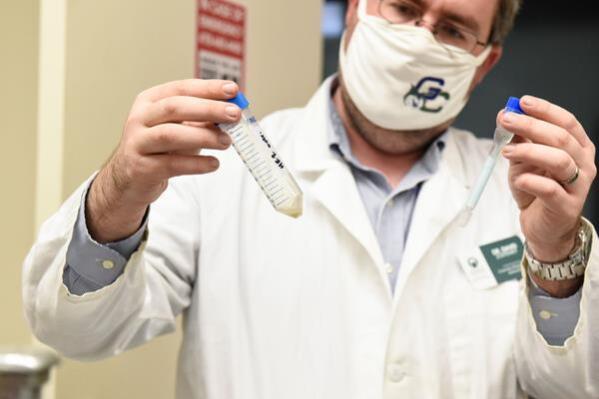Taking the spike out of COVID-19:
Milledgeville, GA, April 27, 2021 (GLOBE NEWSWIRE) -- Its triangular spikes are what make coronavirus such a formidable foe.
But they could also be its Achilles’ heel.
Georgia College Assistant Professor of Chemistry Dr. David Zoetewey and three students are working to expose this weakness and prevent the virus’ spear-like mechanism from harpooning into human cells.
This research could someday result in a medicine that prevents coronavirus from attaching.
“Spike proteins are very important for the virus and its ability to cause infection,” Zoetewey said. “Without the spike protein, there is no viral infection. If we can do something that disrupts how the spike protein works, then we can prevent the virus from becoming infectious.”
Scientists all over the world are working on COVID-19—and the spike protein is just one small piece. Every little bit contributes to our understanding of how the virus works, however, and every step is a step in the right direction.
It’s important to not only eradicate coronavirus—but also be ready for the next pandemic.
“What made COVID-19 so bad was how fast it spreads,” Zoetewey said, “and that’s really made it the perfect storm.”
“It may not be a coronavirus next time. It may be a strain of the flu. It may be something else that we don’t even know of yet,” he said. “The fact we had SARS and then MERS and now COVID-19—and they’re all coronaviruses from the same family—that tells us coronaviruses have high potential to do this again.”
All viruses hijack cells. But the coronavirus known as COVID-19 is particularly cunning, because its pegs act as spears connecting it to other cells. These spikes are proteins, and proteins are built with a sequence of amino acids that dictate their particular shape and movement.
The coronavirus spikes remain folded, until a “a target is recognized,” Zoetewey said. Then, one pops out “like a jackknife” to harpoon into a victim cell—effectively taking command. The harpoon is what enables the two cell membranes to fuse together.
“I’d say all viruses that use this mechanism are devious,” Zoetewey said. “We kind of assign them Machiavellian traits, but it’s just a protein that doesn’t know any better. It’s doing its job. But its job has a bad effect on us.”
Scientists know what the spike protein looks like before and after the harpoon effect. But they can only speculate on what occurs in-between. Working on this small piece of the puzzle, Zoetewey and his students hope to discover how spikes unfold and thrust.
The team is isolating and growing small fragments of the spike protein in bacterium. They’ve applied for a grant from the National Science Foundation (NSF) for a Nuclear Magnetic Resonance machine. It can take pictures of the spike protein in its native state and provide “a living picture” of its movement and function.
Freshman chemistry major Gabe Allred of Eatonton said he was amazed to be doing undergraduate research his first year in college. Even more remarkable, he’s doing research on a virus that’s currently challenging the entire world population.
“I always knew it was a dangerous virus, but it wasn’t until I joined Dr. Zoetewey’s group that I learned what makes it dangerous, and how exactly it spreads from cell to cell and replicates. This was a very fascinating insight to learn about a very prominent problem.”
Attachments
Cindy O’Donnell Georgia College and State University 478-445-8668 [email protected]


